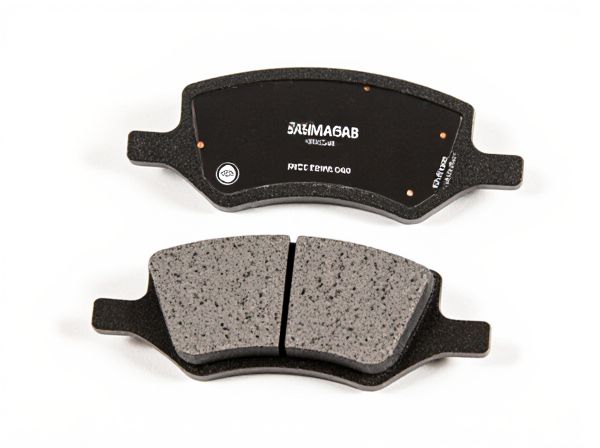
Photo illustration: Ceramic Pad vs Semi-Metallic Pad
Ceramic brake pads offer quieter operation and produce less brake dust, making them ideal for daily driving and maintaining clean wheels. Semi-metallic pads provide superior stopping power and durability, especially under high-performance or heavy-duty conditions, but they tend to be noisier and generate more dust. Choosing the right option depends on your driving style and priorities between comfort and performance.
Table of Comparison
| Feature | Ceramic Brake Pads | Semi-Metallic Brake Pads |
|---|---|---|
| Material Composition | Ceramic fibers, bonding agents, filler materials | Steel fibers, copper, graphite, other metals |
| Performance | Quiet operation, consistent braking, low dust | Strong braking power, better heat dissipation |
| Durability | Long-lasting, less wear on rotors | Moderate lifespan, may wear rotors faster |
| Heat Resistance | Good for normal driving, less suited for extreme heat | Excellent for high-temperature conditions |
| Noise Level | Low noise | Moderate to high noise |
| Brake Dust | Minimal, cleaner wheels | More dust, can dirty wheels |
| Cost | Higher price | More affordable |
| Best Use | Everyday driving, comfort-focused | Performance driving, towing, heavy vehicles |
Introduction to Brake Pads: Ceramic vs Semi-Metallic
Ceramic brake pads are composed of dense ceramic fibers, nonferrous filler materials, and bonding agents, offering quieter operation and less brake dust compared to semi-metallic pads, which combine metal fibers and fillers for enhanced heat dissipation and durability. Semi-metallic brake pads provide superior stopping power and better performance in colder conditions, making them popular for heavy-duty and high-performance vehicles. Ceramic pads emphasize smooth braking and longer lifespan, whereas semi-metallic pads prioritize aggressive braking and thermal resistance.
Composition and Material Differences
Ceramic brake pads are made from a dense ceramic compound blended with copper fibers, offering quieter operation and less brake dust compared to other materials. Semi-metallic brake pads contain a higher percentage of metallic elements such as steel, iron, and copper, which provide better heat dissipation and durability but can cause more noise and wear on rotors. The distinct material composition directly impacts performance characteristics, with ceramic pads excelling in smooth, quiet braking and semi-metallic pads favored for heavy-duty applications requiring enhanced friction and heat resistance.
Performance in Everyday Driving
Ceramic brake pads offer quieter operation, less dust, and consistent performance under normal driving conditions, making them ideal for everyday use. Semi-metallic pads provide superior heat dissipation and stronger braking power, especially during high-stress situations, but may produce more noise and wear faster. For daily commuting, ceramic pads deliver smoother performance and longer lifespan, while semi-metallic pads excel in durability and aggressive braking scenarios.
Durability and Longevity Comparison
Ceramic brake pads typically offer superior durability and longer lifespan compared to semi-metallic pads due to their resistance to wear and heat. Semi-metallic pads may wear out faster under intense driving conditions, though they provide excellent braking performance at a lower cost. In terms of longevity, ceramic pads generally maintain consistent performance over more miles, making them ideal for everyday driving and extended use.
Noise and Vibration Characteristics
Ceramic brake pads produce less noise and vibration compared to semi-metallic pads due to their dense, non-metallic composition that absorbs vibrations effectively. Semi-metallic pads, containing metal fibers, tend to generate more noise and vibration, especially under heavy braking, because of increased friction and metal-on-metal contact. The superior noise-dampening properties of ceramic pads make them ideal for drivers prioritizing quieter braking performance.
Brake Dust Production and Cleanliness
Ceramic brake pads produce significantly less brake dust compared to semi-metallic pads, maintaining cleaner wheels and reducing the need for frequent cleaning. The fine, lighter-colored dust from ceramic pads does not stick to wheel surfaces as stubbornly as the dark, abrasive particles generated by semi-metallic pads. This cleanliness advantage makes ceramic pads popular for high-performance and luxury vehicles where appearance and maintenance are priorities.
Heat Dissipation and Fade Resistance
Ceramic brake pads excel in heat dissipation due to their dense, non-metallic composition, which allows for consistent performance under high temperatures. Semi-metallic pads contain a higher percentage of metal fibers, enhancing heat conduction and fade resistance by quickly dispersing heat during repeated braking. While ceramic pads provide quieter operation and less dust, semi-metallic pads offer superior fade resistance in extreme heat conditions, making them ideal for aggressive driving or towing.
Cost Comparison: Initial and Long-Term
Ceramic brake pads generally have a higher initial cost, ranging from $50 to $100 per set, compared to semi-metallic pads, which typically cost between $30 and $60. Long-term expenses favor ceramic pads due to their extended lifespan and reduced rotor wear, potentially lowering replacement frequency and maintenance costs. Semi-metallic pads, while cheaper upfront, may result in more frequent replacements and increased rotor wear, leading to higher cumulative costs over time.
Suitability for Driving Styles and Conditions
Ceramic brake pads offer quieter braking and produce less dust, making them ideal for daily commuting and light driving conditions. Semi-metallic pads provide superior heat dissipation and better performance under heavy braking, suited for aggressive driving or towing. Choosing between ceramic and semi-metallic pads depends on whether smooth, low-maintenance operation or high-performance braking is the priority.
Choosing the Best Brake Pad for Your Vehicle
Ceramic brake pads offer quieter operation, longer lifespan, and produce less brake dust, making them ideal for everyday driving and light-duty vehicles. Semi-metallic pads provide superior stopping power and heat dissipation, preferred for performance vehicles and heavy-duty applications. Choosing the best brake pad depends on your driving style, vehicle type, and specific needs for durability and braking efficiency.
 caratoz.com
caratoz.com